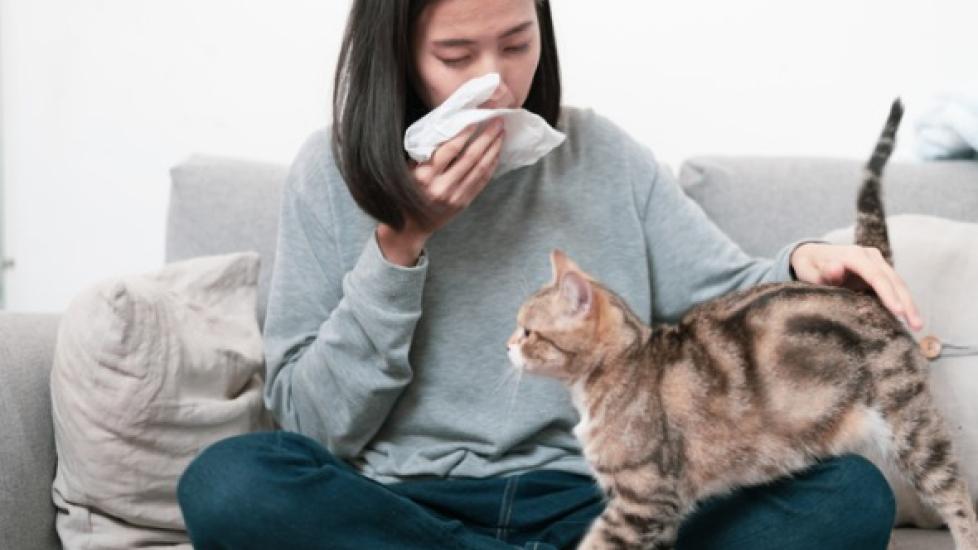Scientists May Have Found Out How to Get Rid of Cat Allergies
That sneezing, wheezing, congested, itchy eye, must-escape-this-room-because-I-can’t-breathe-around-this-cat feeling can ruin even the best of days—especially if you are a cat lover.
But now, you might be able to avoid the allergies altogether, instead of avoiding the furry feline.
You read that right. There have been some very promising scientific breakthroughs that can help alleviate the symptoms of cat allergies altogether. Breathing comfortably without red, itchy eyes could become the norm for allergy sufferers.
And we aren’t talking about allergy shots or desensitization therapy, either.
These new treatments for cat allergies aren’t for you—they’re actually administered to your cat. The goal is to help make them less likely to incite an inflammatory process in you.
Here’s everything you need to know about the potential new cat allergy treatments.
Am I Allergic to Cat Hair?
To help you understand how these new treatments would work, let me quickly break down cat allergies.
If you are amongst the 1 in 5 people worldwide who suffer a range of allergic symptoms when you’re near a cat—or even near someone who has a cat—your allergies are actually NOT caused by the animal’s fur.
This is why a short-haired cat likely invokes the same allergic response as a long-haired Persian cat.
The culprit behind your sneezing and wheezing and puffy eyes is a protein in a cat’s saliva and sebaceous glands (hair follicle glands that produce sebum, an oily secretion that waterproofs their coat and maintains skin health). That glycoprotein is called “Fel d1.”
When cats groom themselves, some hairs break loose and become airborne. The offending protein in the saliva—that Fel d1 allergen—is carried on the hairs, so they become distribution vehicles for the potent allergen that’s causing your inflammatory response.
Recommended Products
Recent Studies for Cat Allergy Cures
For the first time ever, science is offering hope to cat-allergy sufferers everywhere. In just a few years, your options may extend beyond HEPA filters, asthma inhalers, allergy medications and avoidance.
Two studies have discovered different ways to tackle the problem at its root. The idea is to neutralize the feline allergen itself instead of trying to minimize a person’s allergic response.
HypoPet AG Vaccine Study
Scientists at a pharmaceutical company in Switzerland have announced the development of a conjugate vaccine called HypoCat (hypoallergenic cat) that binds to and neutralizes the major cat allergen, Fel d1.
According to the studies recently performed, cats who received the HypoCat vaccine according to the protocol did indeed have lower levels of Fel d1 in the blood.
Although it is somewhat more subjective, the allergic humans involved in the study did show less allergic symptoms around the vaccinated cat compared to unvaccinated cats.
Due to the encouraging results, the Swiss company is moving ahead with registration studies and discussions to bring the vaccine to market in the US and Europe.
HypoPet is hoping to have their HypoCat vaccine on the market in 2022, and they also have a HypoDog vaccine in the pipeline too.
Purina Institute Cat Allergen Diet Study
The Swiss scientists aren’t the only ones to bring a cat de-allergenator to market: Purina Pro Plan LiveClear cat foods.
Purina has taken a different approach to tackling the Fel d1 protein. They are working to neutralize the allergen through a cat’s diet.
The company recently published a study explaining how an egg product ingredient can be introduced to a cat’s diet to help neutralize the major cat allergen, Fel d1.
The concept is similar to the vaccine, with the goal being to decrease levels of active Fel d1 found in cat saliva.
While Purina’s study did not yet incorporate humans’ allergic response rates, an encouraging 86% of cats saw at least a 30% reduction from the baseline Fel d1 levels.
What This Means for Pet Parents With Cat Allergies
The reality is that many people go through extreme efforts to “manage” allergies to keep their beloved feline in their home. While a number of those people are successful, a number are forced to re-home a cat if someone new to the household has an intolerable allergy.
These two studies and potential new products offer a glimpse of hope for cat-allergy sufferers.
As this research is still ongoing, I would anticipate the efficacy of this product only to improve.
Fighting the problem at the source, instead of alleviating the symptoms—it’s so brilliant, and yet so simple. It’s one of those times that I find myself wondering, “Why didn’t I think of that?”
By: Laci Schaible, DVM
Featured Image: iStock.com/domepitipat




